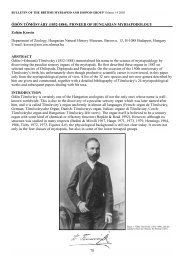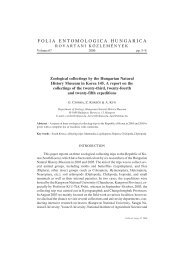History of the Herpetological Collection of the ... - Korsós Zoltán
History of the Herpetological Collection of the ... - Korsós Zoltán
History of the Herpetological Collection of the ... - Korsós Zoltán
Create successful ePaper yourself
Turn your PDF publications into a flip-book with our unique Google optimized e-Paper software.
62 Z. Korsós<br />
As it usually happens with great personalities, MÉHELY in his museum years<br />
(1896–1915) also attracted a series <strong>of</strong> young and talented students who wished to deal with<br />
herpetology. After BOLKAY, <strong>the</strong>re came<br />
(1889–?) who spent some time<br />
studying <strong>the</strong> herpet<strong>of</strong>auna <strong>of</strong> Hungary. He was born in Budapest, and graduated at <strong>the</strong> university<br />
with a degree to teach natural science in high schools. In <strong>the</strong> beginning, in <strong>the</strong> years<br />
1911–1912 he was an unpaid trainee in <strong>the</strong> Department <strong>of</strong> Zoology <strong>of</strong> <strong>the</strong> Hungarian National<br />
Museum. Learning from MÉHELY, he wrote up <strong>the</strong> herpet<strong>of</strong>auna <strong>of</strong> <strong>the</strong> surroundings<br />
<strong>of</strong> Budapest in LENDL’s popular periodical, “A Természet” (=The Nature) in 1914. The<br />
work was illustrated with his own photographs (GEDULY 1914, Fig. 21).<br />
This promising herpetologist career was never<strong>the</strong>less ended for unknown reasons: in<br />
1918 GEDULY accepted a teacher’s position in <strong>the</strong> main high school <strong>of</strong> Budapest, <strong>the</strong>n between<br />
1929–1946 he was teaching natural history in <strong>the</strong> Szent István High School in <strong>the</strong> 7th<br />
district. He did not lose his interest in reptiles though; travelling to Italy in 1928–1931 he<br />
collected several lizards and snakes which he donated to <strong>the</strong> Department <strong>of</strong> Zoology <strong>of</strong> <strong>the</strong><br />
Museum. His important herpetological finding was <strong>the</strong> discovery <strong>of</strong> <strong>the</strong> Viviparous Lizard<br />
(Zootoca vivipara) in <strong>the</strong> middle <strong>of</strong> <strong>the</strong> Great Hungarian Plain (GEDULY 1923). This species<br />
is well known in <strong>the</strong> surrounding countries from higher elevations; but in Hungary, its distribution<br />
is exceptionally confined to certain isolated lowland habitats (like <strong>the</strong> boglands <strong>of</strong><br />
Ócsa and Bátorliget), which resemble with <strong>the</strong>ir cool microclimatic conditions to <strong>the</strong> last<br />
glacial periods.<br />
When MÉHELY left <strong>the</strong> museum and took over <strong>the</strong> university pr<strong>of</strong>essor’s chair in<br />
1915, he had two talented herpetologist students. He chased away one <strong>of</strong> <strong>the</strong>m (BOLKAY),<br />
but <strong>the</strong> o<strong>the</strong>r one (FEJÉRVÁRY), endured his pr<strong>of</strong>essor’s hard personality better, and also his<br />
financial circumstances were luckier concerning his future. He was only 22 when he became<br />
<strong>the</strong> leader <strong>of</strong> <strong>the</strong> <strong>Herpetological</strong> <strong>Collection</strong> in <strong>the</strong> museum.<br />
Baron<br />
(1894–1932) was born into an aristocratic family,<br />
his grandfa<strong>the</strong>r was <strong>the</strong> prime minister <strong>of</strong> <strong>the</strong> Austro-Hungarian Monarchy. He spent his<br />
childhood in Pécs and in Bex in Switzerland, where he went on excursions with BOLKAY in<br />
<strong>the</strong> valley <strong>of</strong> <strong>the</strong> Rhône in 1909. He was barely 15 years old, when his first, 50-page work was<br />
published in German about <strong>the</strong> herpet<strong>of</strong>auna <strong>of</strong> <strong>the</strong> Rhône valley. In 1912 he went to <strong>the</strong><br />
University in Budapest, where he studied zoology and also medical sciences for a while. His<br />
favourite teacher was GÉZA ENTZ Sr., but he could only listen to <strong>the</strong> old teacher’s presentations<br />
for two years. After ENTZ’s retirement his son, GÉZA ENTZ Jr. took over <strong>the</strong> lectures,<br />
but only for one year; when finally MÉHELY became pr<strong>of</strong>essor <strong>of</strong> zoology at <strong>the</strong> university.<br />
Meanwhile, in 1913 FEJÉRVÁRY – as a first-grade university student – became volunteer<br />
keeper <strong>of</strong> <strong>the</strong> <strong>Herpetological</strong> <strong>Collection</strong> (led by MÉHELY at that time). When MÉHELY left<br />
<strong>the</strong> museum in 1915, FEJÉRVÁRY followed him to <strong>the</strong> university and worked as his assistant<br />
(BOROS &DELY 1968). During this period he became acquainted with ARANKA MÁRIA<br />
LÁNGH, whom he later married (Fig. 20), and who also followed him in <strong>the</strong> herpetologist’s<br />
chair <strong>of</strong> <strong>the</strong> museum (DELY 1994).<br />
FEJÉRVÁRY <strong>of</strong>ficially took over <strong>the</strong> curatorship <strong>of</strong> <strong>the</strong> herpetological collection in 1916,<br />
from KÁLMÁN SZOMBATHY (1889–?) who managed <strong>the</strong> collection for only one year, after<br />
MÉHELY in 1915–16. In <strong>the</strong> very same year, he finished his studies at <strong>the</strong> Pázmány Péter<br />
University, and in 1917 he got his doctorate degree. In 1918, at <strong>the</strong> age <strong>of</strong> 24, he published<br />
Annls hist.-nat. Mus. natn. hung. 100, 2008




